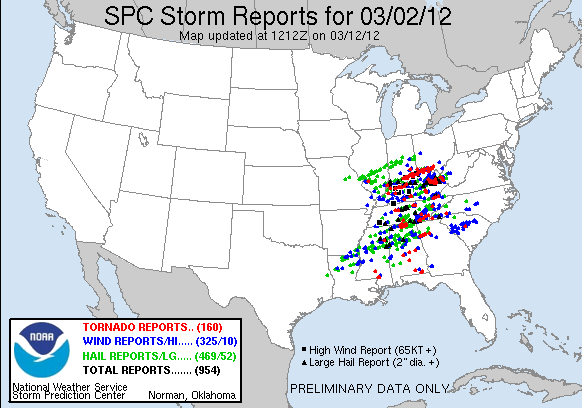Originally posted on ZoomRadar
The month of March started off with a bang, producing the worst severe weather outbreak of the season. The event started on March 2nd and continued into March 3rd, producing 65 confirmed tornadoes including nine EF3 tornadoes and two EF4 tornadoes.
After this outbreak however, it took over a week before the next tornado would be reported. Despite some climatological anomalies, such as a tornado reports in Michigan, South Dakota, and Minnesota, this month has been fairly quiet since the early March outbreak. In fact, the next largest total of tornado reports was 20 which occurred on two occasions, once on the 21st of the month mainly across Louisiana and southern Mississippi and again on the 23rd across the Midwest and parts of the southeast. The number of tornado reports has come no where close to the staggering 160 reports which were received on March 2nd alone.


However, due to the large amount of tornadoes that occurred from that early month outbreak and a few days adding in at least ten tornado reports this month, this year is continuing on its trend as an above average year for tornadoes when considering the 2005 to 2011 average, shown below. In fact, only 2008 had more tornado reports up to this date, with 497 being reported that year compared to this year’s 382.
Will the trend of above average tornadoes continue into April then and can we expect anymore outbreaks in the near future?
For the answers to these questions I will take a look at a few variables which may give us a peak into what April may have in store as far as severe weather goes. The first variable to consider is the NAO, which has remained positive most of the winter. This has allowed for mild air to remain in place over most of the lower 48 states as the jet stream has typically been farther north than usual. However, forecasts are in a general agreement that the NAO should begin to go at least slightly negative as we head into April. From there though it is anyone’s guess as forecasts diverge quickly. If the NAO were to remain negative though, it would allow for some cold air to potentially work its way into the contiguous United States, possibly setting up a battle between air masses which could trigger some severe weather outbreaks.
Another factor to consider is the very warm water which is currently in the Gulf of Mexico. Sea surface temperature readings across this water are easily 1 to 2 degrees Celsius above average with some areas even pushing 4 degrees Celsius above average. This will help bring very warm and moist air into the states anytime a southerly breeze is blowing across this water. Additionally, this warmer than normal water will help keep air temperatures warmer than normal creating for a larger temperature gradient when cold air shots do infiltrate the states.

Additionally, the La Nina pattern we have been in much of the winter is now forecasted to end by the end of April with a return to more neutral conditions. Typically La Nina is responsible for pushing the jet stream further north than usual, which is what we have saw this winter and so far this spring. This allows for severe weather events to take place further north and west of where they would traditionally take place. This is also something we have seen so far this spring with tornadoes occurring in states such as Michigan, Minnesota, and South Dakota as well as numerous tornadoes occurring across the Plains, an areas which typically does not see the peak of their severe weather season until late April and May. So with La Nina weakening and coming to an end, what does this mean for severe weather?
Well, without an El Nino forecasted to take over, the jet stream will be much more susceptible to movement meaning air masses should mix more frequently, leading to at least the potential for more severe weather outbreaks. Of particular note here is the timing of the ending of this La Nina which matches almost perfectly the timing of last year’s La Nina which officially ended around the end of April last year. However, last year’s La Nina was stronger than this year’s so we may not see the same effects as last year’s pattern change, which may be partially to blame for the severe weather outbreaks near the end of last April.
It is important to remember that even with this expected pattern change, synoptic scale events must still occur in order for these outbreak type events to happen and this is not something that can be predicted all that accurately this far in advance. That being said, it does appear that atmospheric circulations are becoming more conducive for severe weather events as we head into the month of April.
So are there any concerns in the short term?
In the short term there will be a few areas at risks for severe storms to end the month of March. While tornadoes cannot be ruled out, no widespread tornado outbreaks should be expected. However, as we enter the month of April we will have to keep a close eye on a trough which should set itself up over the Plains by early next week and continue pushing east as the week progresses. The current Day 4 to Day 8 Severe Weather Outlook from the Storm Prediction Center does highlight an area for a 30% or greater threat of severe weather within 25 miles of a point for Monday and Monday night.
Keep a close eye on this developing situation and look for future blog posts about this potential severe weather outbreak as it gets closer.













































